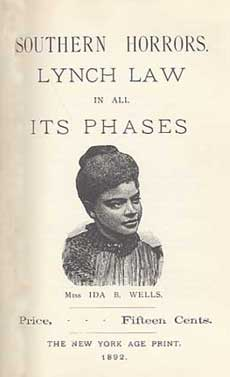A Little Pamphlet that Brought the Horror to Life
- Vincent Rotondo

- Apr 7, 2020
- 4 min read
Updated: Apr 11, 2020
Prior to engaging with the textual information allotted below, please watch this short video, as it is a prelude to our discussion.
* This video provides us with basic understanding of what democracy is - differentiating between a good and flawed democracy. Prior to engaging with Well's work, I would have argued that the United States was always a leading nation functioning on good democratic principles. Maybe you think what I once thought - that is totally okay! Like Sousanis taught us many moons ago, challenge your initial thoughts!
United we stand, divided we fall, and though at times our backs are pitted against the wall, we can always stand together under the flag of our nation and be proud to be an American. The latter notion is just a mere thought that came to mind to reflect upon my political education thus far in my life. I was able to think of this notion quickly without putting much effort into it because it is a compilation of the messages I have received in regards to voting and politics in a free country like the United States. I was born into a different nation than my predecessors - a nation where society learned to come together following terrorist attacks that took place on September 11, 2001.
Although I was an infant at the time when 9/11 happened, the messages I received about our nation from my teachers, parents, and friends is what led me to the conclusion that the United States will always conquer because it is a nation where everyone is and has been united. In fact, I spent my early education learning about 9/11 and the importance of voting for good leaders who are capable of protecting us even in the most disastrous of events. I learned alongside people of very diverse ethnic backgrounds and we were always taught that our voices mattered in politics and voting from messages stemming from Schoolhouse Rock. I can still feel the lingering impact of the rush I felt as a little ten year old learning about the Electoral College for the first time. My teacher taught my class about the Electoral College through engaging lectures and debates, but what stuck with me most was the Schoolhouse Rock episode we watched on loop at the end of each class. I myself could not wait to turn eighteen years old because Schoolhouse Rock impressed me enough to want to vote.
* Thanks to Youtube, the exact message I received in regards to voting as a young boy has been preserved. While it is a short video, it convinced me that the United States has always been so welcoming to all types of voters. Committing myself to further engage in research, I have discovered that my initial proposition on voting which I carried with me to this point stems from a technique known as the magic window. As W. James Potter states in his book, Media Literacy, "researchers use magic window to argue that children initially are led to believe something but can then be vulnerable to many negative effects in the future," (Potter 2020, 150). Read below to learn about my experience of the magic window.
* Reflection after watching the video: At the end of the video, a mini-clip of an elected President of the United States is showcased; however, my teacher made a conscientious effort to point out to his students the individuals who are surrounding the acting president in the clip - people of all different races and backgrounds. One of the most important messages I received about voting in my youth is that we each comprise the United States and have a right to vote once we turn eighteen years old. However, my voting literacy has since been challenged in the making of this Case- Study Analysis because I realize now that this sense of unity in voting was not always the case for the United States.
Life as an eighteen year old African American male during the 1890s demonstrates the deeply rooted complexities in the United States - something I had not realized prior to performing this analysis. Likewise, Ida B. Wells, an African American journalist, published a pamphlet in the 1890s entitled Southern Horrors - this pamphlet showcases the lynchings on African American groups and has since mended a lasting impact on society. Lynchings were typically performed by the anti-African American organization at the time known as the Ku Klux Klan, but the government also intervened by arresting blacks and permitting the mob to enter their prison cells after. (*We all know what the mob did...they like to kill. *) This is a brief historical context, but what is most important is that you come to an awareness of the messages African Americans received in regards to voting - there was no such thing as a message dictating any sort of light at the end of the tunnel, so to speak. Notably, Wells’ pamphlet contains the following message: “they have cheated him out of his ballot, deprived him of civil rights or redress therefore in the civil courts, robbed him of the fruits of his labor, and are still murdering, burning and lynching him,” which presents the image that all black voters during the 1890s were lynched to death (Wells 1892, 15). Likewise, such a notion managed to deter African Americans away from voting despite having been afforded the same voting privileges as white individuals under the Fifteenth Amendment. An eighteen year old African American male who was voting for the first time in the 1890s received very distasteful messages about voting - that if they wanted to end up like the men they read about in Wells’ pamphlet, all they had to do was go out and vote. Would you have taken the chance? I personally would not have...
* Hopefully you found this read to be a bit interesting. Wells transformed the lens through which I saw black aesthetics and culture - I want you to gain a greater awareness of it too. Click on the image below and it will direct you to Southern Horrors. Feel free to read it on your own time!








Comments